
Jean-Baptiste Pierre Antoine de Monet, chevalier de Lamarck, often known simply as Lamarck, was a French naturalist, biologist, academic, and soldier. He was an early proponent of the idea that biological evolution occurred and proceeded in accordance with natural laws.

The Tableau encyclopédique et méthodique des trois regnes de la nature was an illustrated encyclopedia of plants, animals and minerals, notable for including the first scientific descriptions of many species, and for its attractive engravings. It was published in Paris by Charles Joseph Panckoucke, from 1788 on. Although its several volumes can be considered a part of the greater Encyclopédie méthodique, they were titled and issued separately.
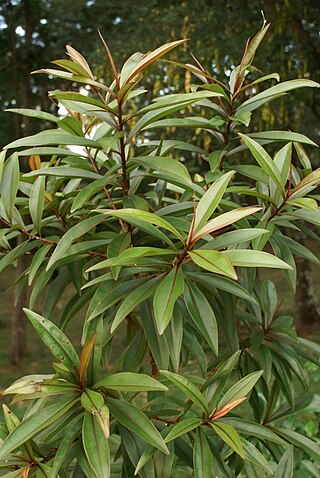
Foetidia is a genus of flowering plants first described as a genus in 1788.

Alangium is a small genus of flowering plants. The genus is included either in a broad view of the dogwood family Cornaceae, or as the sole member of its own family Alangiaceae. Alangium has about 40 species, but some of the species boundaries are not entirely clear. The type species for Alangium is Alangium decapetalum, which is now treated as a subspecies of Alangium salviifolium. All of the species are shrubs or small trees, except the liana Alangium kwangsiense. A. chinense, A. platanifolium, and A. salviifolium are known in cultivation.
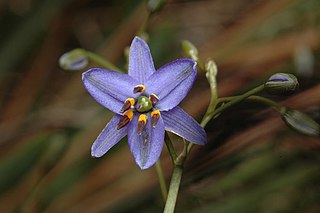
Dianella is a genus of about forty species of flowering plants in the monocot family Asphodelaceae, commonly known as flax lilies. Plants in this genus are tufted herbs with more or less linear leaves and bisexual flowers with three sepals more or less similar to three petals and a superior ovary, the fruit a berry. They occur in Africa, South-east Asia, the Pacific Islands, New Zealand and Australia.

Delosperma echinatum is a succulent plant, native to South Africa. It is also known as the pickle plant. The new genus Delosperma was erected by English botanist N. E. Brown in 1925, with this species later acknowledged as the type species.

Jean Louis Marie Poiret was a French clergyman, botanist, and explorer.

Canthium is a genus of flowering plants in the family Rubiaceae. They are shrubs and small trees. The leaves are deciduous and the stems are usually thorny.

Nuxia is a genus of plants in the family Stilbaceae described as a genus in 1791. It was formerly placed in the Loganiaceae and Buddlejaceae families.

Allocasuarina verticillata, commonly known as drooping sheoak, is a species of flowering plant in the family Casuarinaceae and is endemic to south-eastern Australia. It is a small dioecious tree that has drooping branchlets up to 400 mm (16 in) long, the leaves reduced to scales in whorls of nine to thirteen, the mature fruiting cones 20–50 mm (0.79–1.97 in) long containing winged seeds 7–12 mm (0.28–0.47 in) long.
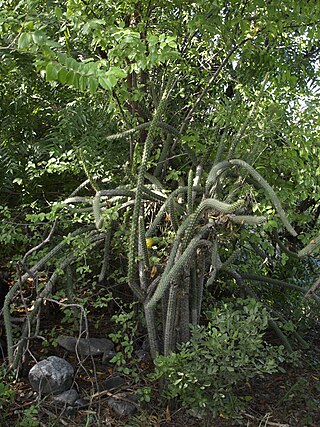
Harrisia divaricata is a species of cactus endemic to Hispaniola.

Hispidella is a genus of flowering plants in the family Asteraceae. The genus is monotypic with only one known species, Hispidella hispanica, native to the Iberian Peninsula.

Helleborus orientalis, the Lenten rose, is a perennial flowering plant and species of hellebore in the buttercup family, Ranunculaceae, native to Greece and Turkey.
Louis Auguste Joseph Desrousseaux was a French botanist and pteridologist. He was a contributor to the "Encyclopedia Botanique" of Lamarck, from 1783 to 1796.

Cossinia is a genus of four species of rainforest trees, constituting part of the plant family Sapindaceae. The genus has a disjunct distribution, occurring in Mascarene Islands, Australia, New Caledonia and Fiji.
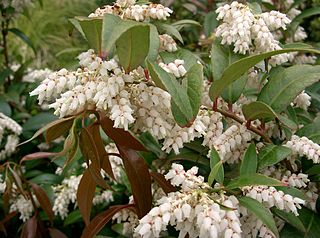
Leucothoe axillaris is a shrub native to the southeastern United States, with the common names swamp dog-laurel and coastal dog-hobble. It has been reported from Louisiana, Mississippi, Alabama, Florida, Georgia, North and South Carolina and Virginia. It grows on floodplains in coastal areas at elevations of less than 200 m (660 ft).
Chromolaena sinuata, the wavyleaf thoroughwort, is a Caribbean species of flowering shrub in the family Asteraceae. It is found on the Islands of Cuba, Hispaniola, Puerto Rico, Guadeloupe, Martinique, La Desirade, Montserrat, St. Eustatius, and Antigua.

Dianthus libanotis, the Mount Libanus pink or Lebanon pink, is a herbaceous perennial plant of the family Caryophyllaceae.

Deeringia amaranthoides is a species of plant in the Amaranthaceae family and is distributed from the western Himalayas east across southern China, down through south east Asia and Indonesia, across New Guinea to parts of Australia.
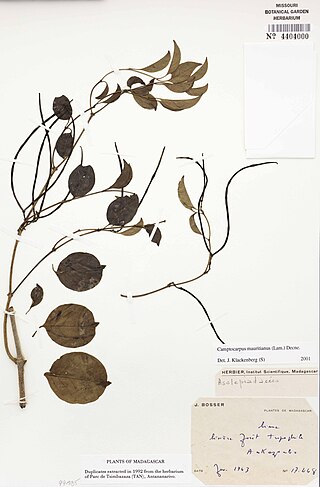
Camptocarpus mauritianus is a species of plant in the Apocynaceae family. It is native to Comoros, Madagascar and Réunion. Jean-Baptiste Lamarck, the naturalist who first formally described the species named it, using the synonym Cynanchum mauritianum, after the region of the Indian Ocean that includes the island of Mauritius, although the type specimen he examined did not list a specific location.


















